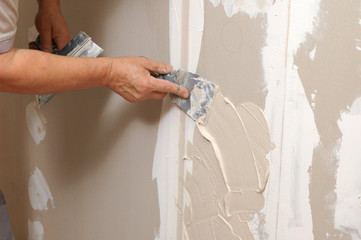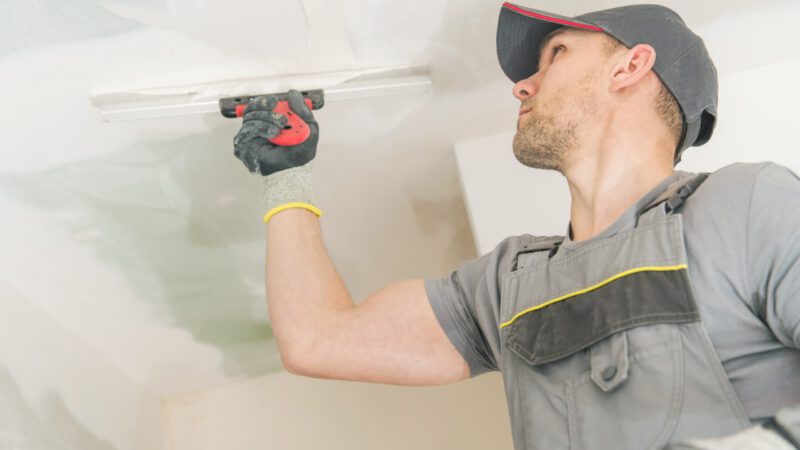Drywall Repair Materials and Methods
Drywall repair is fixing damaged or broken drywall in a building or home. Drywall, or gypsum board or wallboard, is commonly used for walls and ceilings in modern construction. It is made of compressed gypsum and paper and is relatively easy to install and repair.

Professional drywall repair services have the knowledge and experience to diagnose and repair drywall damage accurately. Drywall Repair Las Vegas are familiar with different types of drywall and techniques for repairing them. By hiring professional drywall repair services, homeowners can ensure that the repairs are done the first time correctly, reducing the risk of further damage or costly repairs down the road.
To repair drywall, the damaged area must first be cleaned and prepared. This may involve removing loose debris, sanding the edges of the damaged area, and ensuring the surface is clean and dry. Next, a patch or new piece of drywall may be installed over the damaged area, using joint compound to fill in any gaps and create a smooth surface.
Minor drywall damage like nail holes, dents, and small holes can be quickly repaired with a spackle, a putty knife, sandpaper, and touch-up paint. But you’ll need an expert to fix more serious drywall issues, such as cracks and holes that are more than 1/8″ wide. These can indicate a serious structural problem that you should fix right away.
Tape and joint compounds are the primary materials used for drywall repair. They are available in various forms, including quick-setting and setting compound, mud for embedding tape, topping compound, and lightweight all-purpose drywall mud.
Drywall repair can include repairing holes, indentations, and cracks in the drywall. These repairs can be made using a patch of tape and joint compound or by filling the hole with a brace and then filling it with a drywall patch.
Regardless of the method, it is important to make sure that the paper tape over the seam is embedded in the mud. This requires pressure on the mud to force it into the tape and onto the wall.
The type of tape you use depends on what kind of seams you need to seal, whether they are butt joints (where the sides of 2 pieces of drywall butt up against each other) or tapered joints (where the sides of 2 pieces of plywood are thinner than the rest). A good choice is fiberglass mesh tape, which is a rugged, durable paper tape that is held in place by a layer of joint drywall compound.
Joint adhesives are designed to provide a strong, long-lasting bond for drywall. These adhesives are available for a variety of drywall repairs and can be purchased online or at your local home improvement store.
The choice of joint adhesives is often based on several factors such as the anticipated end-use environment, environmental conditions (temperature, humidity, chemical and UV exposure), and component manufacturers’ changes during the manufacturing process. For example, a new production process that adds a higher percentage of resin to the mix may result in poor bonding strength and lower physical properties.
The most commonly used joint types are single-lap joints, double-lap joints and scarf joints. In order to understand and predict the failure of bonded joints, experimental and numerical studies have been conducted.
Drywall Joint Tape is used to cover seams and corners, and to repair cracks in drywall and plaster. There are two main types of tape: paper and fiberglass-mesh.
Mesh tape is self-adhesive and has a mesh texture that prevents air bubbles from forming. It can also be easier to use for first-time DIYers because of its smooth, uniform texture.
Before you start taping, make sure there are no gaps or other imperfections in the drywall. Gaps 1/8 inch or wider can detract from a drywall’s finished look.
Drywall patch is a self-adhesive mesh and aluminum backing drywall repair patch used to fix holes in drywall. These patches are commonly referred to as style patches and are the ideal solution for large holes in drywall.
They are easy to apply and create strong and durable repairs. They also make an excellent option for repairing holes in ceilings and walls.
To use a drywall patch, cut a piece of scrap drywall several inches larger than the hole on all sides. Score the back of the drywall from each side with a utility knife 1-1/2 inches from each edge.
Once the drywall is cut, cover the entire patch and the tape with a thin layer of joint compound. If necessary, apply a second layer.
Once the patch and joint compound are completely dry, sand it smooth to match the rest of the wall. You can also paint it to hide the patch.

